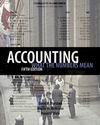 |  Accounting: What the Numbers Mean, 5/e David H. Marshall,
Millikin University
Wayne W. McManus,
International College of the Cayman Islands
Daniel F. Viele,
Webster University
Accounting for and Presentation of Current Assets
Chapter 5 Outline
Cash and Cash Equivalents- Balance sheet valuation -- amount available
- The Bank Reconciliation as a Control Over Cash
- Timing differences
- Deposits in transit
- Outstanding checks
- Charges for bank services
- Interest added to the account
- NSF checks
- Errors
- Adjusting entry(ies) required
|
 |  |  | Short-Term Marketable Securities- Reasons for investing in debt and equity securities
- Balance sheet valuation -- usually at cost, which approximates market
- Interest accrual
|
 |  |  | Accounts Receivable- Balance sheet valuation -- net realizable value
- Bad debts/uncollectible accounts
- Expense recognition/valuation adjustment
- Write-off of uncollectible accounts
- Cash discounts
- Credit terms
- Cash discounts subtracted from revenues in income statement
- Allowance for cash discounts
|
 |  |  | Notes Receivable- Comparison with accounts receivable
- Interest accrual
|
 |  |  | Inventories- Alternative generally accepted practices exist
- Flow of costs from inventory to cost of goods sold
- Inventory cost flow assumptions
- Specific identification
- Weighted average cost
- FIFO
- LIFO
- The impact of changing prices (inflation/deflation)
- The impact of inventory quantity changes
- Selecting an inventory cost flow assumption
- Inventory accounting system alternatives
- Perpetual
- Periodic
- Inventory errors
- Balance sheet valuation at the lower of cost or market
|
 |  |  | Prepaid Expenses and Other Current Assets- Prepaid insurance
- Other prepaid items
|
 |  |  | Deferred Tax Assets- Arise from timing differences: financial accounting income versus taxable
income
- An application of the matching concept
|
|


 2002 McGraw-Hill Higher Education
2002 McGraw-Hill Higher Education